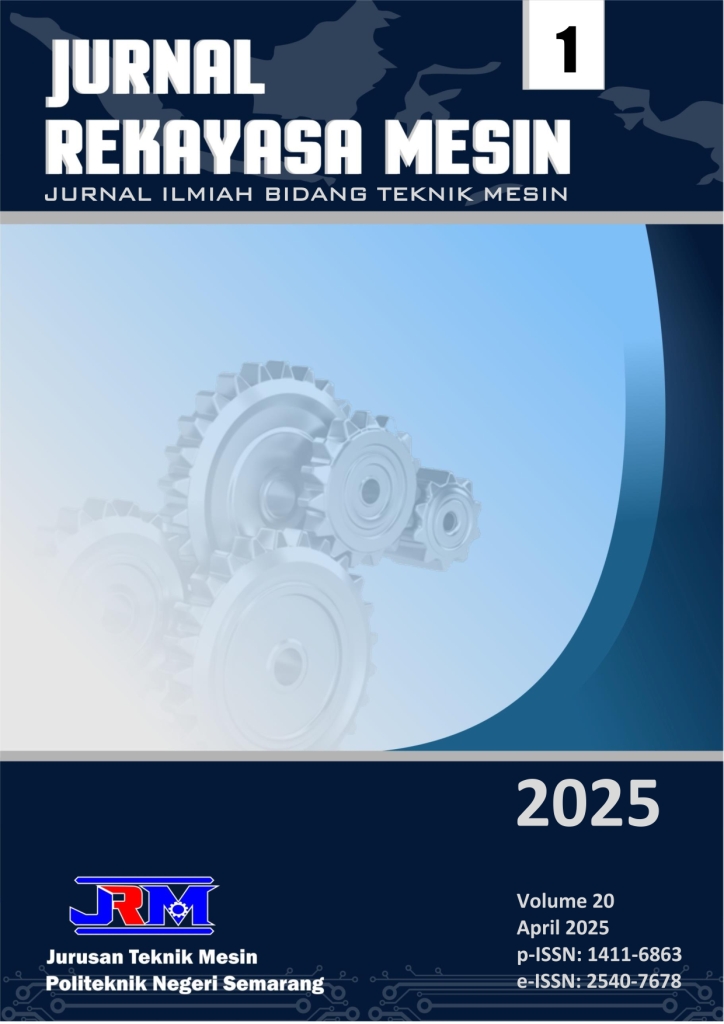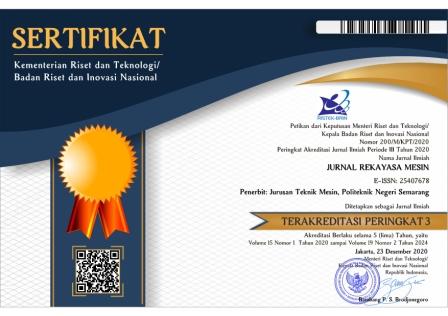Studi Pengaruh Penambahan Komposisi Nano Hidroksiapatit pada Campuran Polylactide dan Poly Ɛ-Caprolactone terhadap Laju Degradasi Fiksasi Internal Pelat Tulang
DOI:
https://doi.org/10.32497/jrm.v20i1.6070Keywords:
degradasi, fiksasi, nano hidroksiapatit, pelat, tulangAbstract
Pemulihan patah tulang menggunakan fiksasi internal pelat yang berfungsi mempertahankan pengurangan retak selama penyembuhan tulang. Fiksasi internal pelat direkomendasikan bersifat biodegradasi secara biologis yang terbuat dari biokomposit polylactide/poly ɛ-caprolactone/nano hidroksiapatit (PLA/PCL/nHA). Material ini memiliki kekuatan mekanik tinggi, namun susah mengontrol waktu laju degradasi. Tujuan penelitian ini menciptakan fiksasi internal pelat dari biokomposit PLA/PCL/nHA dengan laju degradasi dapat diprediksi. Metode pembuatan spesimen dengan Cold Isostatic Pressing (CIP) dengan variasi penambahan prosentase komposisi nHA. Tekanan kompaksi 40 MPa, temperatur sintering 150oC dan waktu penahanan 3 jam. Bertambahnya komposisi nHA mempercepat laju degradasi dan hilangnya berat spesimen. Penambahan komposisi nHA semakin besar untuk erosi permukaan semakin tinggi. Hasil ini untuk rencana implementasi spesimen pada tingkatan umur pasien. Spesimen penambahan 10 wt% nHA untuk pasien diatas umur 50 tahun atau lansia. Spesimen penambahan 20 wt% nHA untuk pasien dewasa, sedangkan spesimen penambahan 30 wt% nHA untuk pasien bayi dan anak-anak.
References
[1] I. H. Sinaga. Analisis Numerik Terhadap Sambungan Prototipe Pengganti Rahang Patah Pada Manusia Menggunakan Perangkat Lunak Solidworks. in Skripsi, Universitas Medan Area, Ed., Medan: repository.uma.ac.id. 2022: p. 7. [Online]. Available: https://repositori.uma.ac.id/handle/123456789/17569
[2] M. S. Gaston and A. H. R. W. Simpson. Inhibition of fracture healing. J. Bone Jt. Surg. - Ser. B. 2007; 89 (12): 1553–1560. doi: 10.1302/0301-620X.89B12.19671.
[3] A. R. MacLeod, P. Pankaj, and A. H. R. W. Simpson. Does screw-bone interface modelling matter in finite element analyses?. J. Biomech. 2012; 45 (9): 1712–1716. doi: 10.1016/j.jbiomech.2012.04.008.
[4] B. Wongchai. The effect of the configuration of the screw fixation on the interfragmentary strain.Am. J. Appl. Sci. 2012; 9 (6): 842–845. doi: 10.3844/ajassp.2012.842.845.
[5] B. L. Eppley and M. Sadove. Comparison of resorbable and metallic fixation in healing of calvarial bone grafts. Plastic and Reconstructive Surgery. Indianana University Medical Center, Indianapolis. 1995; 96 (2): 316–322. doi: 10.1097/00006534-199508000-00009.
[6] B. L. Eppley and M. Reilly. Degradation characteristics of PLLA-PGA bone fixation devices. Journal of Craniofacial Surgery. 1997; 8 (2): 116–120. doi: 10.1097/00001665-199703000-00010.
[7] R. C. Edwards, K. D. Kiely, and B. L. Eppley. The fate of resorbable poly-L-lactic/polyglycolic acid (LactoSorb) bone fixation devices in orthognathic surgery. J. Oral Maxillofac. Surg. 2001; 59 (1): 19–25. doi: 10.1053/joms.2001.19267.
[8] Diah Ayu Lestari. Mengapa Patah Tulang pada Anak Lebih Cepat Sembuh Daripada Orang Dewasa?. hellosehat, 2021. https://hellosehat.com/muskuloskeletal/patah-tulang/patah-tulang-anak-cepat-sembuh/ (accessed Feb. 09, 2021).
[9] F. M. Phillips, P. M. Bolt, T. C. He, and R. C. Haydon. Gene therapy for spinal fusion. Spine J. SUPPL. 2005; 5(6): S250–S258. doi: 10.1016/j.spinee.2005.02.015.
[10] H. C. Wu, F. W. Shen, X. Hong, W. V. Chang, and H. Winet. Monitoring the degradation process of biopolymers by ultrasonic longitudinal wave pulse-echo technique. Biomaterials. 2003; 24 (22): 3871–3876. doi: 10.1016/S0142-9612(03)00135-2.
[11] M. Dawoud, I. Taha, and S. J. Ebeid. Mechanical behaviour of ABS: An experimental study using FDM and injection moulding techniques. J. Manuf. Process. 2016; 21: 39–45. doi: 10.1016/j.jmapro.2015.11.002.
[12] J. W. Li, C. F. Du, C. X. Yuchi, and C. Q. Zhang. Application of Biodegradable Materials in Orthopedics. J. Med. Biol. Eng. 2019; 39 (5): 633–645, 2019. doi: 10.1007/s40846-019-00469-8.
[13] P. A. Netti, M. Biondi, and M. Frigione. Experimental studies and modeling of the degradation process of poly(lactic-co-glycolic acid) microspheres for sustained protein release. Polymers (Basel). 2020; 12 (9). doi: 10.3390/POLYM12092042.
[14] E. K. P. Pentti U. Rokkanen, Ole BoKstma, Eero Hirvensalo, E. Antero MaKkelaK and P. T. laK Hannu PaK tiaK laK, Seppo VainionpaKaK, Kimmo Vihtonen. Bioabsorbable fixation in orthopaedic surgery and traumatology. Biomaterials. 2000; 21 (24): 2607–2613. doi: 10.1586/17434440.1.2.229.
[15] S. Solechan et al..Investigating the Effect of PCL Concentrations on the Characterization of PLA Polymeric Blends for Biomaterial Applications. Materials (Basel). 2022; 15 (20). doi: 10.3390/ma15207396.
[16] O. Böstman and H. Pihlajamäki. Clinical biocompatibility of biodegradable orthopaedic implants for internal fixation: A review. Biomaterials. 2000; 21 (24): 2615–2621. doi: 10.1016/S0142-9612(00)00129-0.
[17] Solechan, J. P. Rubijanto, J. Triyono, and E. Pujiyanto. Study of Making Implant Plate and Screen of Femur Bone Internal Fictation from Hydroxyapatit Bovine and Polymer Biodegradation Material Using 3D Printers on Mechanical Strength. IOP Conf. Ser. Mater. Sci. Eng. 2019; 494 (1): 11–18. doi: 10.1088/1757-899X/494/1/012070.
[18] M. Alizadeh-Osgouei, Y. Li, and C. Wen. A comprehensive review of biodegradable synthetic polymer-ceramic composites and their manufacture for biomedical applications. Bioact. Mater. 2019; 4 (1): 22–36. doi: 10.1016/j.bioactmat.2018.11.003.
[19] E. Pietrzykowska. Preparation of a ceramic matrix composite made of hydroxyapatite nanoparticles and polylactic acid by consolidation of composite granules. Nanomaterials. 2020; 10 (6). doi: 10.3390/nano10061060.
[20] S. Solechan. Characterization of PLA/PCL/Nano-Hydroxyapatite (nHA) Biocomposites Prepared via Cold Isostatic Pressing. Polymers (Basel). 2023; 15 (3): 1–17. doi: 10.3390/polym15030559.
[21] P. Chen, Q. Shen, G. Luo, M. Li, and L. Zhang. The mechanical properties of W-Cu composite by activated sintering. Int. J. Refract. Met. Hard Mater. 2013; 36: 220–224. doi: 10.1016/j.ijrmhm.2012.09.001.
[22] Z. Jiao, B. Luo, S. Xiang, H. Ma, Y. Yu, and W. Yang. 3D printing of HA / PCL composite tissue engineering scaffolds. Adv. Ind. Eng. Polym. Res. 2019; 2 (4): 196–202. doi: 10.1016/j.aiepr.2019.09.003.
[23] A. Gallo. On the prospect of serum exosomal miRNA profiling and protein biomarkers for the diagnosis of ascending aortic dilatation in patients with bicuspid and tricuspid aortic valve. Int. J. Cardiol. 2018; 273 (xxxx): 230–236. doi: 10.1016/j.ijcard.2018.10.005.
[24] S. Sadudeethanakul, W. Wattanutchariya, W. Nakkiew, A. Chaijaruwanich, and S. Pitjamit. Bending strength and Biological properties of PLA-HA composites for femoral canine bone fixation plate. IOP Conf. Ser. Mater. Sci. Eng. 2019; 635 (1). doi: 10.1088/1757-899X/635/1/012004.
[25] Andrew Ruys. Alumina Ceramics Biomedical and Clinical Applications A volume in Woodhead Publishing Series in Biomaterials, 1st ed. English: Elsevier B.V. 2019. doi: https://doi.org/10.1016/C2017-0-01189-8.
[26] G. Xiong. Characterization of biomedical hydroxyapatite/magnesium composites prepared by powder metallurgy assisted with microwave sintering. Curr. Appl. Phys. 2016; 16 (8): 830–836. doi: 10.1016/j.cap.2016.05.004.
[27] A. Arifin, A. B. Sulong, N. Muhamad, J. Syarif, and M. I. Ramli. Material processing of hydroxyapatite and titanium alloy (HA/Ti) composite as implant materials using powder metallurgy: A review. Mater. Des. 2014; 55: 165–175. doi: 10.1016/j.matdes.2013.09.045.
[28] ISO. ISO 10993-13:2010 Biological evaluation of medical devices. ISO, 2010. https://www.iso.org/standard/44050.html (accessed Nov. 22, 2010).
[29] M. Diba, M. Kharaziha, M. H. Fathi, M. Gholipourmalekabadi, and A. Samadikuchaksaraei. Preparation and characterization of polycaprolactone/forsterite nanocomposite porous scaffolds designed for bone tissue regeneration. Compos. Sci. Technol. 2012; 72 (6): 716–723. doi: 10.1016/j.compscitech.2012.01.023.
[30] A. Göpferich. Mechanisms of polymer degradation and erosion1. Biomater. Silver Jubil. Compend. 1996; 17 (2): 117–128. doi: 10.1016/B978-008045154-1.50016-2.
[31] S. Hassanajili, A. Karami-Pour, A. Oryan, and T. Talaei-Khozani. Preparation and characterization of PLA/PCL/HA composite scaffolds using indirect 3D printing for bone tissue engineering. Mater. Sci. Eng. C. 2019;104: 109960. doi: 10.1016/j.msec.2019.109960.
[32] T. Semba. Effect of Compounding Procedure on Mechanical Properties and Dispersed Phase Morphology of Poly(lactic acid) Polycaprolactone Blends Containing Peroxide. J. Appl. Polym. Sci. 2006; 103 (5): 1066–1074. doi: 10.1002/app.
[33] E. Åkerlund, A. Diez-Escudero, A. Grzeszczak, and C. Persson. The Effect of PCL Addition on 3D-Printable PLA/HA Composite Filaments for the Treatment of Bone Defects. Polymers (Basel). 2022; 14 (16). doi: 10.3390/polym14163305.
[34] J. P. Mofokeng and A. S. Luyt. Morphology and thermal degradation studies of melt-mixed poly(hydroxybutyrate-co-valerate) (PHBV)/poly(ε-caprolactone) (PCL) biodegradable polymer blend nanocomposites with TiO2 as filler. J. Mater. Sci. 2015; 50 (10): 3812–3824. doi: 10.1007/s10853-015-8950-z.
[35] J. A. Tamada and R. Langer.Erosion kinetics of hydrolytically degradable polymers. Proc. Natl. Acad. Sci. U. S. A. 1993; 90 (2): 552–556. doi: 10.1073/pnas.90.2.552.
[36] von B. Friederike, S. Luise, and G. Achim. Why degradable polymers undergo surface erosion or bulk erosion. Biomaterials. 2002; 23 (21): 4221–4231. [Online]. Available: https://doi.org/10.1016/S0142-9612(02)00170-9
[37] E. Wulandari, F. R. A. Wardani, N. Fatimattuzahro, and I. Dewa Ayu Ratna Dewanti. Addition of gourami (Osphronemus goramy) fish scale powder on porosity of glass ionomer cement. Dent. J. 2022; 55 (1): 33–37. doi: 10.20473/j.djmkg.v55.i1.p33-37.
[38] Z. Fang and Q. Feng. Improved mechanical properties of hydroxyapatite whisker-reinforced poly(l-lactic acid) scaffold by surface modification of hydroxyapatite. Mater. Sci. Eng. C. 2014; 35 (1): 190–194. doi: 10.1016/j.msec.2013.11.008.
[39] M. Mohseni, D. W. Hutmacher, and N. J. Castro. Independent evaluation of medical-grade bioresorbable filaments for fused deposition modelling/fused filament fabrication of tissue engineered constructs. Polymers (Basel). 2018; 10 (1). doi: 10.3390/polym10010040.
[40] C. X. F. Lam, R. Olkowski, W. Swieszkowski, K. C. Tan, I. Gibson, and D. W. Hutmacher. Mechanical and in vitro evaluations of composite PLDLLA/TCP scaffolds for bone engineering. Virtual Phys. Prototyp. 2008; 3 (4): 193–197. doi: 10.1080/17452750802551298.
[41] M. Allione et al. Micro/nanopatterned superhydrophobic surfaces fabrication for biomolecules and biomaterials manipulation and analysis. Micromachines. 2021;12 (12). doi: 10.3390/mi12121501.
[42] G. S. Kwon and D. Y. Furgeson. Biodegradable polymers for drug delivery systems. Woodhead Publishing Limited. 2007. doi: 10.1533/9781845693640.83.
[43] C. A. Vacanti, K. T. Paige, W. S. Kim, J. Sakata, J. Upton, and J. P. Vacanti. Experimental tracheal replacement using tissue-engineered cartilage. J. Pediatr. Surg. 1994; 29 (2): 201–205. doi: 10.1016/0022-3468(94)90318-2.
[44] Debra D. Wright, Degradable Polymer Composites, 1st ed. Boca Raton: CRC Press. 2015. doi: https://doi.org/10.1201/9781351237970.
[45] J. Kost and R. Langer. Responsive polymer systems for controlled delivery of therapeutics. Trends Biotechnol. 1992; 10 (C): 127–131. doi: 10.1016/0167-7799(92)90194-Z.
[46] P. Agus, Penyembuhan Patah Tulang, 1st ed. Surabaya: Fakultas Kedokteran Gigi Universitas Airlangga. 1989. [Online]. Available: http://repository.unair.ac.id/id/eprint/116129
[47] C. Shuai et al. Cellulose nanocrystals as biobased nucleation agents in poly-L-lactide scaffold: Crystallization behavior and mechanical properties. Polym. Test. 2020; 85 (January): 106458. doi: 10.1016/j.polymertesting.2020.106458.
[48] H. Zhou and J. Lee. Nanoscale hydroxyapatite particles for bone tissue engineering. Acta Biomater. 2011; 7 (7): 2769–2781. doi: 10.1016/j.actbio.2011.03.019.
[49] W. Weng, G. Han, P. Du, and G. Shen. The effect of citric acid addition on the formation of sol-gel derived hydroxyapatite. Mater. Chem. Phys. 2002; 74 (1): 92–97. doi: 10.1016/S0254-0584(01)00399-6.
[50] D. Tang, R. S. Tare, L. Y. Yang, D. F. Williams, K. L. Ou, and R. O. C. Oreffo. Biofabrication of bone tissue: Approaches, challenges and translation for bone regeneration. Biomaterials. 2016; 83: 363–382. doi: 10.1016/j.biomaterials.2016.01.024.
[51] J. H. G. Rocha, A. F. Lemos, S. Kannan, S. Agathopoulos, and J. M. F. Ferreira. Hydroxyapatite scaffolds hydrothermally grown from aragonitic cuttlefish bones. J. Mater. Chem. 2005; 15 (47): 5007–5011. doi: 10.1039/b510122k.
[52] C. Y. Wee et al. Investigating the degradation behaviour and characteristic changes of phase pure hydroxyapatite (HAp) microsphere scaffolds under static and dynamic conditions. Mater. Technol. 2022; 37 (12): 2242–2254. [Online].
Downloads
Published
How to Cite
Issue
Section
License
Copyright (c) 2025 Jurnal Rekayasa Mesin

This work is licensed under a Creative Commons Attribution-NonCommercial-ShareAlike 4.0 International License.
Copyright of articles that appear in Jurnal Rekayasa Mesin belongs exclusively to Penerbit Jurusan Teknik Mesin Politeknik Negeri Semarang. This copyright covers the rights to reproduce the article, including reprints, electronic reproductions, or any other reproductions of similar nature.







